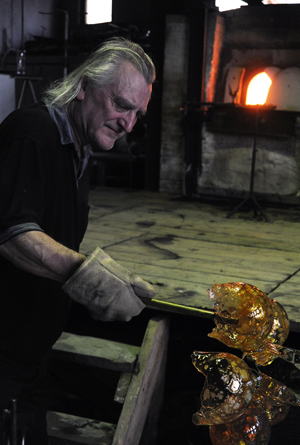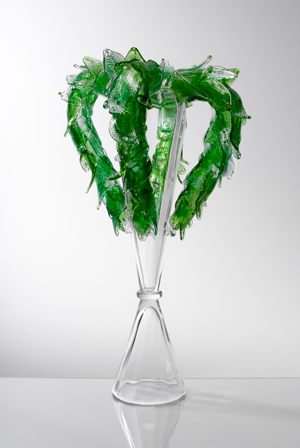 |
 |
 |
 |
 |
 |
| |
 |
|
 |
 |
 |
  |
  |
 |
 |
 |
 |
|
 |
 |
Bořek Šípek
|
|
* Prague [Praha], Czechoslovakia [Československo], 14 June 1949 |
|
+ Prague [Praha], Czech Republic [Ceska Republika], 13 February 2016 |
| nationality:
czech |
|
 |
|
|
|
|
 |
 |
 |
BIOGRAPHICAL NOTES |
 |
|  |
|
 |
 |
 |
| |
 |
 A world-renowned architect and designer Bořek Šípek (1949) has been dedicated to working with glass from the very beginning of his creative career. He gained his first experiences from his guardian, a glass artist Rene Roubíček. In 1968, Šípek went to Germany where he studied architecture and philosophy. After relocating to the Netherlands, he began to work on various designs of buildings and interiors. Bořek Šípek experienced his first significant successes in the early eighties, when his work began to interest the most prestigious Italian design company, Driade. The interest in his work is steeply rising; the number of proposals for cooperation with renowned companies is increasing. The dining sets designs for Sèvres are developed, he participated on the realization of the Museum of Modern Art in Den Bosch in the Netherlands, designed the Opera House in Kyoto, Japan, he helped to realize the Ginza store in Tokyo. His name is associated with the image of the famous Parisian Lagerfeld’s boutique for whom he created the Bible of boutiques. The best-known global companies of renowned brands such as Leitner Interior Designer, Vitra Editions Steltman or Franz Wittmann Möbelwerkstätten give him an absolute freedom for his designing works. He has received several prestigious awards. In 1983 he received the German Award for Architecture, in 1991 the title Knight of Arts and Literature of the French Republic, and in 1993 the Award of Prince Bernhard for Applied Arts and Architecture. A world-renowned architect and designer Bořek Šípek (1949) has been dedicated to working with glass from the very beginning of his creative career. He gained his first experiences from his guardian, a glass artist Rene Roubíček. In 1968, Šípek went to Germany where he studied architecture and philosophy. After relocating to the Netherlands, he began to work on various designs of buildings and interiors. Bořek Šípek experienced his first significant successes in the early eighties, when his work began to interest the most prestigious Italian design company, Driade. The interest in his work is steeply rising; the number of proposals for cooperation with renowned companies is increasing. The dining sets designs for Sèvres are developed, he participated on the realization of the Museum of Modern Art in Den Bosch in the Netherlands, designed the Opera House in Kyoto, Japan, he helped to realize the Ginza store in Tokyo. His name is associated with the image of the famous Parisian Lagerfeld’s boutique for whom he created the Bible of boutiques. The best-known global companies of renowned brands such as Leitner Interior Designer, Vitra Editions Steltman or Franz Wittmann Möbelwerkstätten give him an absolute freedom for his designing works. He has received several prestigious awards. In 1983 he received the German Award for Architecture, in 1991 the title Knight of Arts and Literature of the French Republic, and in 1993 the Award of Prince Bernhard for Applied Arts and Architecture.
 After returning to his homeland, Šípek became - in the spirit of his original glass maker profession – a co-founder of the now famous glass company Ajeto with workshops in Nový Bor and Lindava. At the same time, he began to act as the main architect of Prague Castle and became the only artist who, after Josip Plecnik could interfere with the architectural and visual appearance of the castle interiors. At that time, unique chandeliers and other lamps, vases, sets of drinking glasses, glass furniture components and other interior equipment for the representative areas of the Castle were created under the guidance of an architect. Last but not least, also several official glass gifts, which Vaclav Havel used during his foreign visits. In many statesmen and royal families, glass works by Bořek Šípek are used as part of their interiors. His works are owned by many foreign and domestic artists - Mick Jagger, Bob Dylan, Karl Lagerfeld, Jean Paul Gautier, alongside Vaclav Havel, Marta Kubišová, Jan Tříska, Michael Kocáb, Halina Pawlovská, Jan Saudek, and many other celebrities. In his work, he builds on the strong tradition of Czech glass, which he treats with humility and yet with his characteristic self-confidence. Fascinated by traditional Czech glass techniques, he brings to the Czech glass a worldwide influence, which is the direct result of his nomadic life. His enthusiasm for the Czech Baroque is reflected in his fancy to pompous shapes, which he originally combines with strict geometric lines and seemingly mindless colorful accessories. In addition to the free designs he also works on designing of functional objects, but in his own words, the functionality is the starting point, not the goal. After returning to his homeland, Šípek became - in the spirit of his original glass maker profession – a co-founder of the now famous glass company Ajeto with workshops in Nový Bor and Lindava. At the same time, he began to act as the main architect of Prague Castle and became the only artist who, after Josip Plecnik could interfere with the architectural and visual appearance of the castle interiors. At that time, unique chandeliers and other lamps, vases, sets of drinking glasses, glass furniture components and other interior equipment for the representative areas of the Castle were created under the guidance of an architect. Last but not least, also several official glass gifts, which Vaclav Havel used during his foreign visits. In many statesmen and royal families, glass works by Bořek Šípek are used as part of their interiors. His works are owned by many foreign and domestic artists - Mick Jagger, Bob Dylan, Karl Lagerfeld, Jean Paul Gautier, alongside Vaclav Havel, Marta Kubišová, Jan Tříska, Michael Kocáb, Halina Pawlovská, Jan Saudek, and many other celebrities. In his work, he builds on the strong tradition of Czech glass, which he treats with humility and yet with his characteristic self-confidence. Fascinated by traditional Czech glass techniques, he brings to the Czech glass a worldwide influence, which is the direct result of his nomadic life. His enthusiasm for the Czech Baroque is reflected in his fancy to pompous shapes, which he originally combines with strict geometric lines and seemingly mindless colorful accessories. In addition to the free designs he also works on designing of functional objects, but in his own words, the functionality is the starting point, not the goal.
Among other interesting orders undoubtedly belonged an architectural project of the exhibition pavilion SKODA in Wolfsburg, Germany for the World Exposition EXPO 2000, completely designed by Šípek, for which the glassworks in Lindava manufactured large lamps, glass interior parts, and other three-dimensional installations. An interesting, and at the same time prestigious, was the project of equipping the VIP area of the Ruzyně airport, called the Crystal Lounge. Between the years 2000 and 2001 new designs and realizations of about two hundred glass objects arose; they were intended for exclusive lounges of two modern ocean vessels - Carnival Pride and Carnival Spirit. For the renovated Opera House in central Belgrade, he created the chandelier - its parameters are admirable: length of 15 meters, width of approximately 3.5 meters and built from a total of 400-450 glass parts.
In 2004, the staff of famous German china brand ROSENTHAL approached Šípek, with an offer for cooperation. Subsequently, thematically wide-ranging and highly successful collections of Rosengarden 2004 were introduced, followed by other realizations. A limited collection of porcelain wall lights called “Fragile” was also introduced by Šípek in Prague at Designblok 2008. For several years, he has been working with Czech Television, for which he designed the price for the competitive program with a focus on the history - “The Crown of King Charles” and Thálie Prize, which is awarded by the Association of Performing Republic to artists for their outstanding dramatic performances. Very creditable is also Šípek’s educational activity - in the nineties, he worked at the University of Applied Arts in Prague, then at the University of Applied Arts in Vienna. During the last years, he was the Dean of the Faculty of Architecture of the Technical University in Liberec, where he founded an entirely new study program, "the Environmental Design".
In 2008 was Bořek Šípek involved in installing the first exhibition of Czech artists in Beijing, China. In another Chinese city, Shanghai, he received a significant honor - he was allowed to build his own gallery using his own design and exhibit his best works there. Such an offer is not in today's world common at all, and it indicates Šípek’s extraordinary position among the world's current designer giants. Šípek’s design work, admired for its the extravagant shapes and playful colors, is also represented in prominent museums of the world - in Düsseldorf, London, Paris, Amsterdam, New York, and of course in Prague.
One of the latest major projects is designing the memorial of the slaves dragged away from Africa, called a Memorial de Gorée, which he designed along with Martin Gudev for Senegal. At the beginning of this year, he opened his own glassworks in Nový Bor, named “Studio Anežka” (Agnes Studio.)
Bořek Šípek likes to exist completely unlimited. |
|
 |
 |
 |
BUILDINGS |
 |
|
 |
|
 |
 |
 |
|
|
 |
|
|
|
 |
|
 |
 |
 |
 |
EXHIBITIONS |
 |
|
|
 |
|
 |
 |
 |
|
|
 |
| F.O.O.D. (Food, Objects, Objectives, Design), Charlotte (NC), Mint Museum Uptown, 2 march / 7 july 2013 |
|
|
| Borek Sipek. Facelift Chairs, Los Angeles, Pacific Design Center, North Gallery, 15 november / 24 december 2012 |
|
 |
  |
 |
|
|